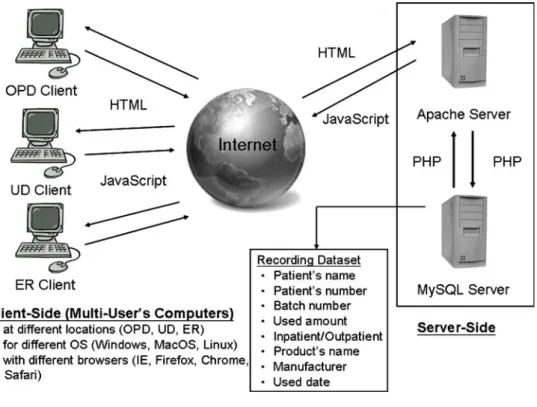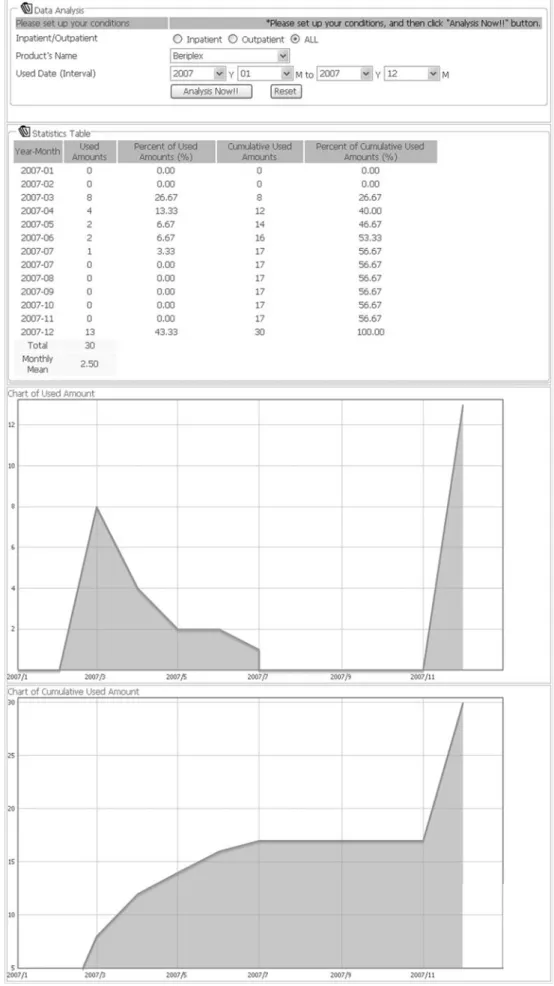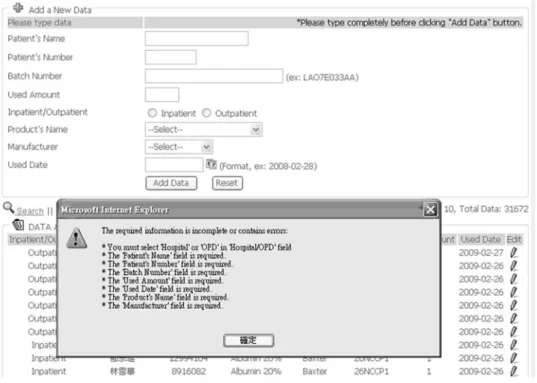ORIGINAL PAPER
WebBio, a Web-Based Management and Analysis System
for Patient Data of Biological Products in Hospital
Ying-Hao Lu&Chen-Chun Kuo&Yaw-Bin Huang
Received: 11 August 2009 / Accepted: 23 October 2009 / Published online: 24 November 2009 # Springer Science + Business Media, LLC 2009
Abstract We selected HTML, PHP and JavaScript as the programming languages to build “WebBio”, a web-based system for patient data of biological products and used MySQL as database. WebBio is based on the PHP-MySQL suite and is run by Apache server on Linux machine. WebBio provides the functions of data management, searching function and data analysis for 20 kinds of biological products (plasma expanders, human immuno-globulin and hematological products). There are two particular features in WebBio: (1) pharmacists can rapidly find out whose patients used contaminated products for medication safety, and (2) the statistics charts for a specific product can be automatically generated to reduce pharma-cist’s work loading. WebBio has successfully turned traditional paper work into web-based data management. Keywords Web-based . Data management and analysis . Biological products . Internet . Database
Introduction
Most biological products are complex mixtures of sugars, proteins, nucleic acids or a combination of these substan-ces, and derived from living organisms like humans, animals and microorganisms [1]. Therapeutic biological products are widely used to prevent or treat a variety of
diseases, such as hepatitis B immunoglobulin for hepatitis B post-exposure prophylaxis [2] and Factor VIII for hemophilia treatment [3]. The Center for Biologics Evalu-ation and Research (CBER) within the FDA provides a wide definition of biological products including allergenic extract, blood/blood components, gene therapy, devices and test kits, human tissue/cellular products used in transplan-tation and vaccines [4]. The specific features of biological products are heat sensitivity and susceptibility to microbial contamination, therefore, appropriate storage and sterile processing are necessary [5]. However contaminated events from natural sources (such as HIV or parasitic infection) would happen occasionally, and they may be vital. In order to trace patients using such infected biological products, it is routine to record patient data of biological products when hospital pharmacists dispense any special medications. In hospitals, pharmacists work in many locations including OPD (Out-Patient Department), UD (Unit-Dose Depart-ment) and ED (Emergency DepartDepart-ment), therefore the recording data are scattered. In addition to data integration from different locations, it is difficult and not efficient to determine infected biological products from paper-recorded data. To survey current information systems in biomedicine in recent years, the web-based mode has become a more convenient way to collect data [6–10]. The major advan-tages of internet technology include time saving, cost savings, rapidity, limited geographic constraints and more efficient data processing.
The purposes of this study are (1) to develop a user-friendly tool to assist hospital pharmacists to efficiently record patient data of biological products at any place; (2) to provide a rapid search function to determine which patients are using contaminated biological products for medication safety; and (3) to develop the facilities of automatically generated data nomograms.
Electronic supplementary material The online version of this article (doi:10.1007/s10916-009-9394-2) contains supplementary material, which is available to authorized users.
Y.-H. Lu
:
C.-C. Kuo:
Y.-B. Huang (*)College of Pharmacy, Kaohsiung Medical University, Kaohsiung, Taiwan
e-mail: yabihu@kmu.edu.tw DOI 10.1007/s10916-009-9394-2
Fig. 1 The mechanism of Web-Bio that multi-users at different locations manage and analyze patient data relating to biological products
Fig. 2 Screenshot of the data recording and management interface
Material and methods
Computational methods and related tools
In order to work at any place, we utilized internet-based technology to develop this system. The webpage program languages were selected as the coding technology to build this system, and we named this system “WebBio” which stands for “Web-based System for Biological Products”. HTML, Hypertext Markup Language was applied to build the basic structure of web pages. PHP, Hypertext Prepro-cessor is mainly used in server-side application (http:// www.php.net/) and JavaScript is a client-side script lan-guage (http://javascript.internet.com/). We select MySQL as a database to manage our data (http://www.mysql.com/), Apache as a HTTP web server (http://httpd.apache.org/) and Linux as a server OS (operating system) (http://www. linux.org/). PHP has an API (application programming interface) that allows applications to rapidly access MySQL databases. Based on the Apache-PHP-MySQL configura-tion on Linux server, WebBio would allow multi-users parallel access at the same time and at different locations to record and utilize patient data of biological products (Fig.1). ProtoChart is a free chart library using Prototype and Canvas technology to create various types of charts (http://www.deensoft.com/lab/protochart/). Scal is a
Java-Script calendar/date picker also based on the Prototype library (http://scal.fieldguidetoprogrammers.com/). The two open-source tools are used to exploit some functions in WebBio.
Recording data and list of biological products
Our hospital is a medical center in Taiwan and includes 1,179 beds, 545 physicians, 93 pharmacists and about 2,100,000 patient amounts in 2009. The recording data contained the patient’s name, patient’s number, batch number, used amount, Inpatient/Outpatient, product’s name, manufacturer and used date. There are several biological products in our hospital and these are classified as three main types of plasma expanders, human immunoglobulin and hematological products (ESM1).
Results and discussion System description
From July 2002 to June 2009, WebBio included 35,833 records and 20 kinds of biological products (ESM 1). WebBio is a web-based system with high-level security to protect patient data. Pharmacists must enter their account and password to login to this system and can easily operate on the internet with various browsers, such as Internet Fig. 3 Screenshot of the
Fig. 4 Screenshot of the data analysis
Explorer (IE), Firefox, Chrome and Safari. In WebBio, there are three main functions: data management, the searching function and data analysis. The data management of WebBio contained “Add Data”, “Edit Data” and “View Data” to assist pharmacists to easily cope with these data. (Fig.2) The most useful function is the searching function where pharmacists can set some specific conditions (such as patient’s name, batch number or product’s name) to rapidly find out the results they want. (Fig.3) This function can be applied to contaminated events and would quickly seek out which patients used what. For data analysis, pharmacists could set up a certain time interval for a specific product to automatically generate statistical tables and charts. These nomograms are calculated and drawn according to used amounts and accumulative used amounts in each month (Fig.4). There are two “Help” functions in WebBio: (1) the automatic checking function avoids possible key-in errors made by pharmacists and assistant error messages would tell pharmacists“what is wrong, and how to correct it” (Fig.5); (2) pharmacists can easily input used date of biological products with JavaScript calendar picker. (Fig.2)
System requirements and limitations
WebBio is based on the PHP-MySQL suite and run by Apache server on a Linux machine. Related software packages (such as ProtoChart and Scal) are all free and
run well in most Linux distributions, so that WebBio can be easily implemented into another Linux-based OS. The only requirement of client-side computers for internet access using any kind of browser is that end-users require no specialized computer skills to operate this system running on the common OS (Windows XP/Vista, Mac OS X or Linux). Due to private patient data of our hospital, WebBio is not open to members of the public. The limitation was that WebBio can not automatically gain patient’s information from hospital database to record and users must input these data manually. If WebBio could be connected with hospital"s electronic data system, the data management will be more efficient.
Conclusion
For management of biological products, we have success-fully turned traditional paper work into a web-based data management system. In addition to achieve reduction in direct and indirect costs of data collection and management, WebBio also saves time in identifying contaminated biological products thereby playing an important role in medication safety. Specially speaking, WebBio provides the automatic data analysis function of statistics charts to reduce pharmacist’s work loading and these nomograms are useful to discuss the trend of medication use in P&T committees (Pharmacy and Therapeutics Committee).
Fig. 5 Screenshot of the assistant pop-up window for input errors
References
1. FDA. Therapeutic Biological Products. Retrieved February 28, 2009, fromhttp://www.fda.gov/cder/biologics/.
2. Pai, M. P., Mercier, R. C., and Raebel, M. A., Viral hepatitis (Chapter 40 737–760). In: DioPiro, J. T., Talbert, R. L., Yee, G. C., Matzke, G. R., Well, B. G., and Posey, L. M. (Eds.), Pharmacotherapy—A Pathophysiologic Approach, 6th edition. McGraw-Hill, New York, 2005.
3. Petros, W. P., and Ericson, S., Hematopoiesis (Chapter 98 1793– 1804). In: DioPiro, J. T., Talbert, R. L., Yee, G. C., Matzke, G. R., Well, B. G., and Posey, L. M. (Eds.), Pharmacotherapy—A Pathophysiologic Approach, 6th edition. McGraw-Hill, New York, 2005.
4. Center for Biologics Evaluation and Research. The Classification of Biological Products. Retrieved February 28, 2009, fromhttp:// www.fda.gov/cber/.
5. Buchholz, S., Gangi, V. J., Johnson, A., Little, J., Mendivil, S., Trott, C., Webber, K., and Weinstein, M., Results of a survey of biological drug and device industries inspected by FDA under the
Team Biologics Program. PDA J. Pharm. Sci. Technol. 61:211– 222, 2007.
6. Lee, J., Kim, J., Lee, J., Hwang, S., Lee, B., Jeong, K., et al., The study on the web-based clinical database management system of oriental pulse waveform. J. Med. Syst. 25:277–284, 2001. 7. Thriskosa, P., Zintzarasa, E., and Germenisb, A., DHLAS: A
web-based information system for statistical genetic analysis of HLA population data. Comput. Methods Prog. Biomed. 85:267–272, 2007.
8. Zuberbuhler, B., Galloway, P., Reddy, A., Saldana, M., and Gale, R., A web-based information system for management and analysis of patient data after refractive eye surgery. Comput. Methods Prog. Biomed. 88:210–216, 2007.
9. Kelly, K. J., Walsh-Kelly, C. M., Christenson, P., Rogalinski, S., Gorelick, M. H., Barthell, E. N., et al., Emergency department allies: A web-based multihospital pediatric asthma tracking system. Pediatrics. 117:S63–S70, 2006.
10. Knop, C., Reinhold, M., Roeder, C., Staub, L., Schmid, R., Beisse, R., et al., Internet based multicenter study for thoraco-lumbar injuries: A new concept and preliminary results. Eur. Spine J. 15:1687–1694, 2006.


